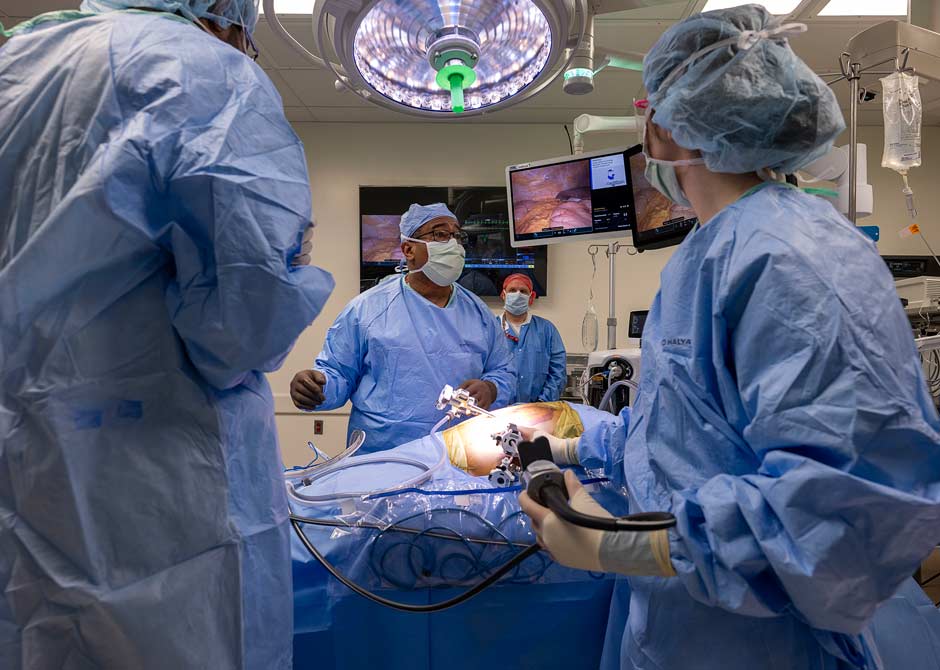 Ohio State surgeons have aided in the development and U.S. Food and Drug Administration (FDA) approval of the most advanced da Vinci surgical robot.
Ohio State surgeons have aided in the development and U.S. Food and Drug Administration (FDA) approval of the most advanced da Vinci surgical robot.
Ten Ohio State surgeons are credited with helping the machine through clinical trials and FDA approval.
“This is the first robotic update for the system in a decade,” says Michael Meara, MD, MBA, clinical associate professor of Surgery in the Department of Surgery and the medical director of Robotic Surgery at the Ohio State Wexner University Medical Center. “From an under-the-hood standpoint, it’s a massive leap forward.”
Ohio State’s da Vinci 5, made by Intuitive, was the first operational version in the Midwest in spring 2024.
Some of the latest advances are game-changing for both surgeons and patients.
How the da Vinci 5 improves robotic surgery
“There’s improved tactile feedback,” says Robert Merritt, MD, a thoracic surgeon at The Ohio State University Comprehensive Cancer Center – Arthur G. James Cancer Hospital and Richard J. Solove Research Institute (OSUCCC – James) and the division director of Thoracic Surgery.
The latest upgrades include improved tremor controls for the surgeon, which make the system smoother and more precise.
“The system will alert the surgeon when they’re exerting too much force on tissue, which certainly will result in less tissue damage. It will translate to better patient outcomes,” Dr. Merritt says.
Clinical trials conducted with patients showed the da Vinci 5 is safe for patients and performed just as well as did previous surgical robots.
Tissue damage to patients is expected to be reduced by 43% compared to the previous models. The more tissue damage is reduced, the faster patients heal.
World-class training and care
“We’re proud that the expertise of our clinical and research teams helped us be selected as one of the clinical trial sites for the latest da Vinci model,” says Heidi Pieper, program director of the Center for Minimally Invasive Surgery and the Center for Advanced Robotic Surgery.
Ohio State was the first institution to enroll in the trial and had the most patient participants. The first patients enrolled in December 2022, and the trial lasted for six months.
Better training for surgeons to become skilled at robotic surgery
Surgeons undergo extensive training before they step into their first robotic surgery. The da Vinci 5 can track every movement a surgeon makes while training and stores that information in a database.
It can develop algorithms that show the difference between precise expert surgeons’ movements and those of a novice.
Data shows expert surgeons need far fewer movements to complete a surgery while less-experienced surgeons tend to make more movements to complete the same surgery.
“The tactile feedback integrated into this new technology removes a big barrier to training. It alerts surgeons when there’s too much pressure,” Dr. Meara says.
A robot with a bigger brain
Many of the advances with the da Vinci 5 are ones that aren’t clearly apparent.
“It’s like jumping from an iPhone 6 to an iPhone 15,” Dr. Meara says.
Future updates could include incorporating advanced imaging, highlighting anatomic structures and even physically identifying cancer.
The new model has 10,000 times more computing power compared to the last model.
“It’s faster,” he says. “It’s able to perform tasks it could not do previously. It’s also able to acquire and interpret information on the fly that we couldn’t previously.”
Ohio State’s history of robotic surgery
That innovation is the latest chapter in the Ohio State Wexner Medical Center’s storied robotics program dating back to 1999.
“Ohio State is certainly one of the busiest and highest volume robotic programs in the country,” Dr. Merritt says.
As of October 2024, Ohio State had completed more than 34,350 robotic surgeries in various specialties, including cardiac, transplant, ENT, colorectal, gynecology, urology, general surgery, thoracic surgery and surgical oncology since the program’s inception.
Two out of 16 robots in Ohio State’s surgical arsenal are da Vinci 5s.
Ohio State’s robotics program has 80 surgeons from 14 surgical specialties and trains 168 surgical residents and fellows per year.
